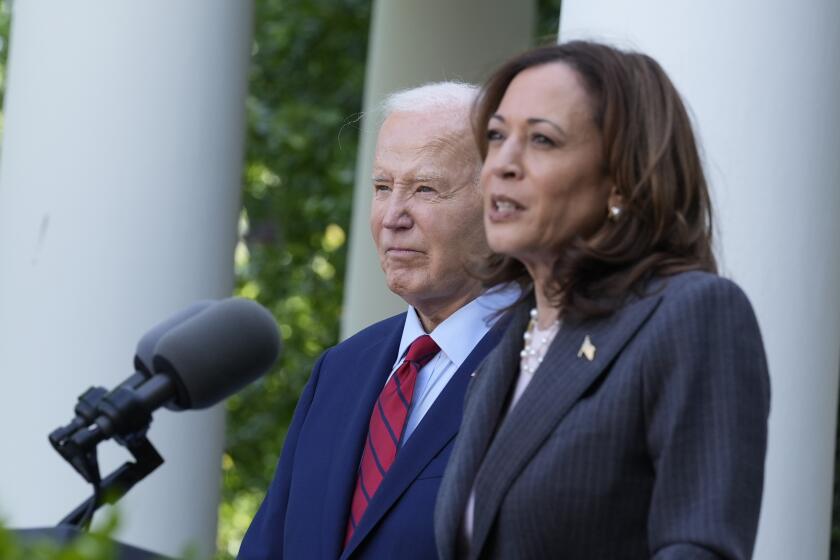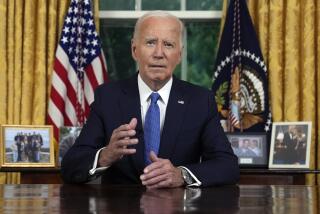Column: How Joe Biden’s tenacity became his Achilles’ heel

WASHINGTON — Joe Biden never hid his ambition to be president, or the chip he carried on his shoulder from feeling underestimated for most of his long career.
He needed three tries to reach the White House. When he began running the first time, in 1987, he was 44; when he finally won the prize he sought, in 2020, he was 77.
That victory wasn’t easy, either. In 2020, when Biden finished fourth in the Iowa caucuses and fifth in the New Hampshire primary, pundits gave him up for dead. But he shook off the naysayers to win the Democratic nomination, and defeated then-President Trump by a convincing 4.5-point margin in the popular vote in November.
Long before 2020, persistence in the face of adversity was Biden’s story. His national political career began in tragedy when his wife and daughter were killed in a traffic accident shortly before his first swearing-in as a senator in 1973.
“When you’re knocked down, you get up,” he said after every setback in his life — and there were many.
When Biden was right, that tenacity was one of his most useful traits. When he was wrong, it looked more like stubbornness.
President Biden’s decision to bow out of the November election leaves a path for Vice President Kamala Harris to replace him that would have seemed unlikely for most of the last three years.
That’s certainly how it has looked over the last six months, as Biden rejected every evidence that his advancing age was not only sparking doubts among voters, but crippling his ability to run an effective campaign.
Depending on the outcome of November’s election after his belated decision to withdraw, his lifelong stubbornness may prove to have been his tragic flaw.
It is almost difficult to remember now, only four years later, how perfectly then-candidate Joe Biden of 2020 matched the moment. He waged a campaign promising to “heal the soul of the nation” after four years of chaotic governance under Trump culminated in a disastrous response to the COVID-19 pandemic.
The Republican convention’s lesson was that there is no New Trump — only one committed to cementing the MAGA transformation of the GOP for generations.
The election brought not only Biden’s victory, but Democratic control of both the Senate and House of Representatives. The new-but-septuagenarian president seized the opportunity to pass a raft of long-sought liberal priorities. As a token of his ambition, he hung a portrait of Franklin D. Roosevelt, the transformative Democratic leader of the 20th century, in the Oval Office.
In his first two years in office, using legislative skills he prided himself on as senator and vice president, he enacted a $1.2-trillion infrastructure bill; a clean energy bill that was the largest climate-related program in U.S. history; and major programs to finance manufacturing and technology.
He also passed a $1.9-trillion economic stimulus bill to hasten the end of the recession that the pandemic had caused. Many economists say the large stimulus contributed to an inflation spike in 2022 and 2023 — but it also made the U.S. economy recover faster and stronger than those of most other industrial nations.
That list didn’t match the epochal achievements of FDR’s New Deal, but it bore comparison to Lyndon B. Johnson’s record of civil rights and voting rights laws and Medicare.
Trump is promising militia members who fight for him that if he wins, they will not only be protected from the law, they will be celebrated as heroes.
As the 2022 congressional election approached, rising prices dragged down Democrats’ popularity and pundits predicted a “red wave.” Biden waged the campaign as a defense of democracy against Trump and “MAGA Republicans.” Some Democrats warned that it was a losing message — but Biden stuck to his guns. A surprisingly high percentage of voters unhappy about the economy voted for Democrats, enabling them to keep control of the Senate and lose fewer seats than expected in the House.
In retrospect, that moment — the end of 2022 — was the apogee of Biden’s power.
With the House in Republican hands, he could no longer pass major legislation. He would have to focus on implementing the programs already passed, and on preparing to run for a second term — if he chose to.
During the 2020 campaign, he said he viewed himself as a “transitional president,” a wise old hand who would send Trump into retirement and hand the baton to a new generation. It looks now as if he never really meant it.
Trump was asked whether the election would end in political violence if he lost. “It depends,” the former president said. Here’s what he meant by that.
Now in the office he had sought so long, he was in no hurry to give it up. And when Trump announced in November 2022 that he was running again, Biden decided he was still his party’s indispensable man.
His wife, Jill, his son Hunter and the rest of his family ratified the decision over Thanksgiving on Nantucket.
Biden had just turned 80, and already most voters said he was too old for a second term. Most Democratic voters said they wanted someone else to run. But there was no formal debate in the party; as an incumbent president, the decision was Biden’s to make.
Vice President Kamala Harris, if she wins the nomination, will have big challenges in starting a presidential campaign, a process that normally takes months.
When reporters asked if he had the stamina for another campaign, his invariable response was: “Watch me.”
In retrospect, that was the moment Biden should have decided not to run. He would have been going out on top.
He could have opened the way for his party to hold an open nomination contest, with two full years for contenders to organize their campaigns.
By September 2023, three-quarters of all voters, including most Democrats, told pollsters they thought the president was too old to run again.
Biden’s life experience told him the critics were wrong. This time, they weren’t.
“I think I’m the most qualified person to run for president. I beat him once, and I will beat him again,” he said at a news conference on July 11. “I got more work to do.”
But that was already two weeks after his disastrous debate performance against Trump, when he proved unable to defend his own accomplishments in a coherent way or knock down Trump’s torrent of misstatements and outright lies.
Panic spread among Democrats who believed they were heading for a defeat that would give Trump control of the White House and both houses of Congress.
For three weeks, Biden’s stubbornness held firm. He had beaten the critics and pundits before, and he seemed certain he could do it again. But his allies were deserting him. On Sunday, he gave in — with a letter that was grimly eloquent, as if dictated through clenched teeth.
We don’t know yet how this story turns out.
If Vice President Kamala Harris or another Democrat wins the November election, Biden will be remembered as a strikingly successful one-term president, one whose withdrawal was a heroic sacrifice that saved his party’s future.
But if Trump returns to the White House and Republicans take control of Congress, Biden will not only see the central purpose of his 2020 campaign undone, but many of his legislative achievements potentially repealed.
Biden’s successes could yet turn to ashes — and the tragedy will be that his stubbornness was partly to blame.
More to Read
Sign up for Essential California
The most important California stories and recommendations in your inbox every morning.
You may occasionally receive promotional content from the Los Angeles Times.
















